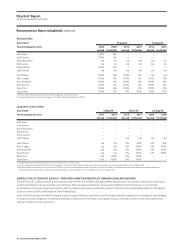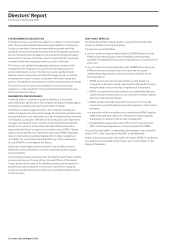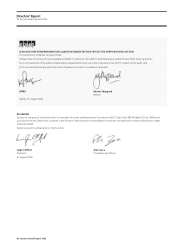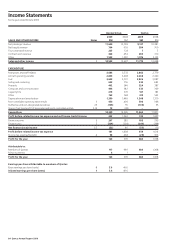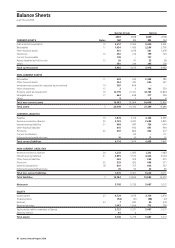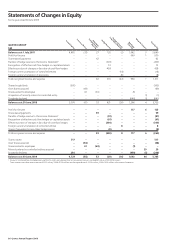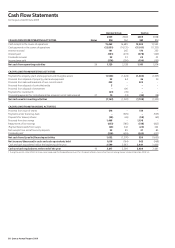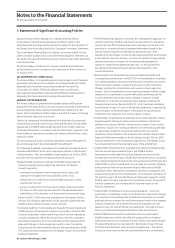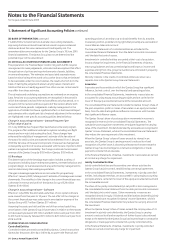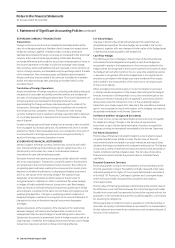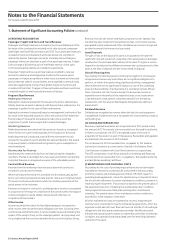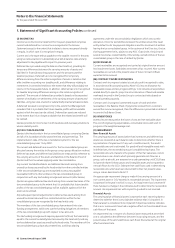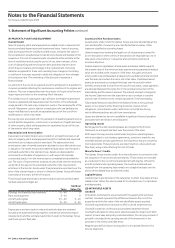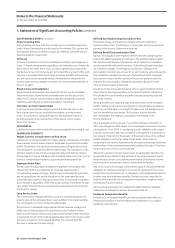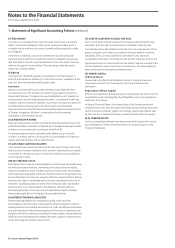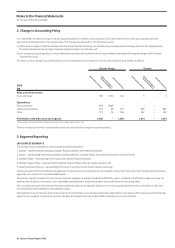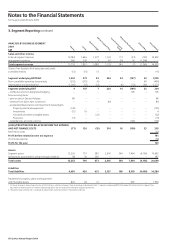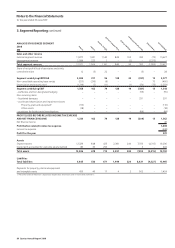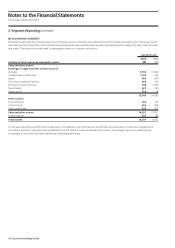Qantas 2009 Annual Report Download - page 93
Download and view the complete annual report
Please find page 93 of the 2009 Qantas annual report below. You can navigate through the pages in the report by either clicking on the pages listed below, or by using the keyword search tool below to find specific information within the annual report.
91 Qantas Annual Report 2009
Notes to the Financial Statements
for the year ended 30 June 2009
1. Statement of Significant Accounting Policies continued
(E) FOREIGN CURRENCY TRANSACTIONS
Transactions
Foreign currency transactions are translated to Australian dollars at the
rates of exchange prevailing at the date of each transaction except where
hedge accounting is applied. At balance date, monetary assets and
liabilities denominated in foreign currencies are translated to the functional
currency at the rates of exchange prevailing at that date. Resulting
exchange differences are brought to account as exchange gains or losses in
the Income Statement in the year in which the exchange rates change.
Non-monetary assets and liabilities that are measured in terms of historical
cost in a foreign currency are translated using the exchange rate at the date
of the transaction. Non-monetary assets and liabilities denominated in
foreign currencies that are stated at fair value are translated to Australian
dollars at foreign exchange rates prevailing at the dates the fair value
was determined.
Translation of Foreign Operations
Assets and liabilities of foreign operations, including controlled entities and
investments in associates and jointly controlled entities, are translated at
the rates of exchange prevailing at balance date. The Income Statements of
foreign operations are translated to Australian dollars at rates
approximating the foreign exchange rates prevailing at the dates of the
transactions. Exchange differences arising on translation are recorded in
the foreign currency translation reserve. The balance of the foreign
currency translation reserve relating to a foreign operation that is disposed
of, or partially disposed of, is recognised in the Income Statement in the
year of disposal.
Foreign exchange gains and losses arising from a monetary item receivable
from or payable to a foreign operation, the settlement of which is neither
planned nor likely in the foreseeable future, are considered to form part of
a net investment in a foreign operation and are recognised directly in
equity in the foreign currency translation reserve.
(F) DERIVATIVE FINANCIAL INSTRUMENTS
Qantas is subject to foreign currency, interest rate, fuel price and credit
risks. Derivative financial instruments are used to hedge these risks. It is
Qantas policy not to enter into, issue or hold derivative financial
instruments for speculative trading purposes.
Derivative financial instruments are recognised at fair value both initially
and on an ongoing basis. Transaction costs attributable to the derivative
are recognised in the Income Statement when incurred. The method of
recognising gains and losses resulting from movements in market prices
depends on whether the derivative is a designated hedging instrument,
and if so, the nature of the risk being hedged. The Qantas Group
designates certain derivatives as either hedges of the fair value of
recognised assets or liabilities or a firm commitment (fair value hedges);
or hedges of highly probable forecast transactions (cash flow hedges).
Gains and losses on derivative financial instruments qualifying for hedge
accounting are recognised in the same Income Statement category as the
underlying hedged item. Changes in underlying market conditions or
hedging strategies could result in recognition in the Income Statement of
changes in fair value of derivative financial instruments designated
as hedges.
Qantas documents at the inception of the transaction the relationship
between hedging instruments and hedged items, as well as its risk
management objective and strategy for undertaking each transaction.
Qantas also documents its assessment, both at hedge inception and on an
ongoing basis, of whether the hedging instruments that are used in hedge
transactions have been and will continue to be highly effective.
Fair Value Hedges
Changes in the fair value of derivative financial instruments that are
designated and qualify as fair value hedges are recorded in the Income
Statement, together with any changes in the fair value of the hedged asset
or liability that are attributable to the hedged risk.
Cash Flow Hedges
The effective portion of changes in the fair value of derivative financial
instruments that are designated and qualify as cash flow hedges are
recognised in equity in the hedge reserve. Amounts accumulated in the
hedge reserve are recognised in the Income Statement in the periods when
the hedged item will affect profit or loss (i.e. when the underlying income
or expense is recognised). Where the hedged item is of a capital nature,
amounts accumulated in the hedge reserve are transferred from equity
and included in the measurement of the initial cost or carrying amount
of the asset or liability.
When a hedging instrument expires or is sold, terminated or exercised,
or Qantas revokes designation of the hedge relationship but the hedged
forecast transaction is still expected to occur, the cumulative gain or loss
at that point remains in equity and is recognised in accordance with the
above policy when the transaction occurs. If the underlying hedged
transaction is no longer expected to take place, the cumulative unrealised
gain or loss recognised in equity with respect to the hedging instrument is
recognised immediately in the Income Statement.
Ineffective and Non-designated Derivatives
From time to time, certain derivative financial instruments do not qualify
for hedge accounting. Changes in the fair value of any derivative
instrument, or part of a derivative instrument, that does not qualify for
hedge accounting are recognised immediately in the Income Statement.
Fair Value Calculations
The fair value of financial instruments traded in active markets is based
on quoted market prices at balance date. The fair value of financial
instruments that are not traded in an active market are estimated using
valuation techniques consistent with accepted market practice. The Qantas
Group uses a variety of methods and input assumptions that are based on
market conditions existing at balance date. The fair value of derivative
financial instruments includes the present value of estimated future
cash flows.
Financial Guarantee Contracts
Financial guarantee contracts are recognised as a financial liability at the
time the guarantee is issued. The liability is initially measured at fair value
and subsequently at the higher of the amount determined in accordance
with AASB 137 Provisions, Contingent Liabilities and Contingent Assets
and the amount initially recognised less cumulative amortisation,
where appropriate.
The fair value of financial guarantees is determined as the present value of
the difference in net cash flows between the contractual payments under
the debt instrument and the payments that would be required without the
guarantee, or the estimated amount that would be payable to a third party
for assuming the obligations.
Where guarantees in relation to loans or payables of controlled entities or
associates and jointly controlled entities are provided for no compensation,
the fair values are accounted for as contributions and recognised as part of
the cost of the investment.


